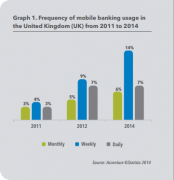Banks should know their customers’ digital skills says new report
 As consumer adoption of mobile devices and social media increases, banks can’t really rely on standard details such as income, age and geography to serve customers better than their competitors, according to a new report by payments company TSYS and software firm FICO. Instead, they may need to recognise the different kinds of customers based on how they interact with digital technology and tailor their services accordingly.
As consumer adoption of mobile devices and social media increases, banks can’t really rely on standard details such as income, age and geography to serve customers better than their competitors, according to a new report by payments company TSYS and software firm FICO. Instead, they may need to recognise the different kinds of customers based on how they interact with digital technology and tailor their services accordingly.
The report, Engaging Customers: Why Should Financial Institutions Move Toward a ‘Bring Your Own Persona’ Approach, notes that more than two billion people are using social media worldwide. Digital consumers are more demanding and expect more customised services, so banks that can best meet that expectation will stand to gain more satisfied and loyal customers.
One of the most significant statistics behind the report is a finding by Deutsche Bank that mobile banking consumers on average interact with their bank more frequently, up to three times more than consumers who bank online and 20 times more than those who bank via their branch. In the UK mobile banking weekly usage grew from 4% in 2011 to 14% in 2014 and is expected to keep growing.
The document also highlights the importance of identifying new customer segments and categorising consumers by their level of digital engagement and the extent to which they are comfortable sharing information. This information can then be used to create a profile of the type of customer and serve them accordingly.
“Relying solely on data such as income, age and geography isn’t enough in the digital age, customers expect banks to understand their preferred communications channels, willingness to share personal data in various scenarios and ability to transact,” said Bruno Courbage, senior director of product management at FICO. “Financial institutions’ relationships with their customers are changing, largely driven by two key influencers- the adoption of enabling technology and the insight available from big data.”
Historically, a big part of the impetus for banks to collect more information about their customers was the introduction of KYC regulations to deter fraud and money laundering. But the TSYS/FICO report suggests that the consequences of that information gathering process are still playing out. Beyond compliance, the information can provide banks with insights that can help banks to make sure their message reaches the customer in the best way based on each individual’s preferences. As example highlighted in the report is the ability to send customers a text message notification, instead of a paper letter. The text message is lower cost for the bank and for some consumers it may be a much better fit with their lifestyle.
The report also notes that banks could use public Facebook data to evaluate a customer’s risk profile. They could also analyse a customer’s circle of friends to determine their risk, income level, spending potential and other traits to structure a tailored marketing plan to that person. “While regulators’ attitudes vary by country, this could technically all be done today,” it read. Indeed, in some countries such as Russia, it is already being done by firms such as TCS, which evaluates potential customers based on social media activity as well as other factors such as their web browser history and their online behaviour.
Based on the University of Pennsylvania’s Wharton School blog, written by Scott Snyder, the TSYS/FICO report divided customers into several ‘personas’: the analogue consumer, who can’t or won’t use digital technologies for personal reasons; the wannabes who are not very experienced with digital technologies but are eager to learn; the mainstreamers who represent the middle of the market; the paranoids, who are very cautious and protective of their data and may ‘lash out’ if they fear their personal information is being misused; the chameleons, who are digital-savvy users who are well educated about privacy policies of different brands; and the digital nomads, who are happy sharing data if it benefits them and who make full use of digital profiles.
The report measured a test group of consumers and found that 28% of them were analogues, 18% wannabes, 18% mainstreamers, 20% paranoids, 6% chameleons and 10% nomads. “Banks that embrace big data and use it to better understand their customers’ habits and preferences and combine it with the user experience will have a strategic advantage” over those that do not, added John Goodale, group executive, product and market development at TSYS International.











































